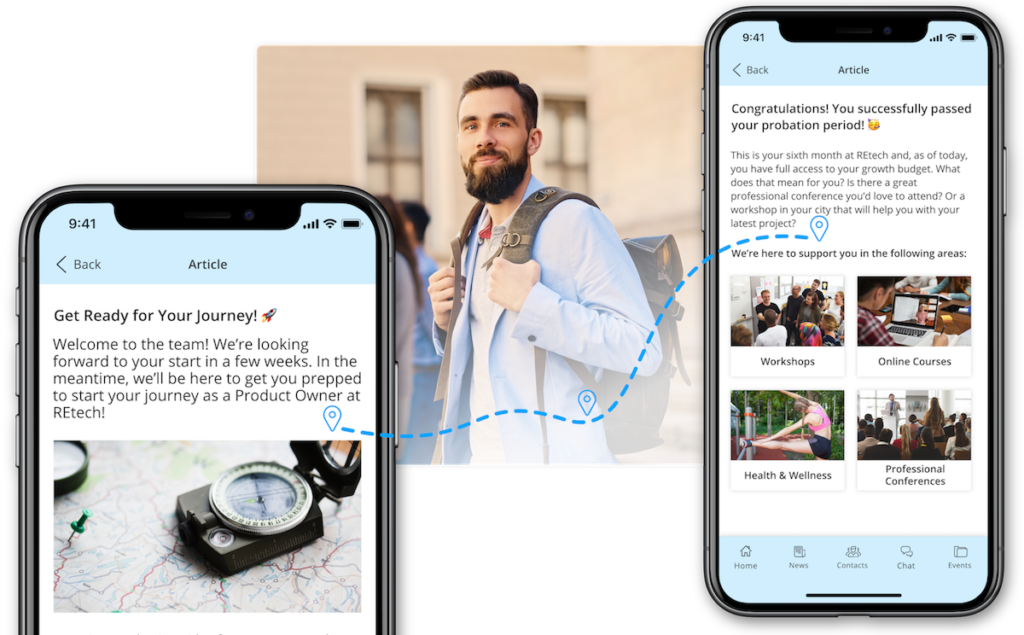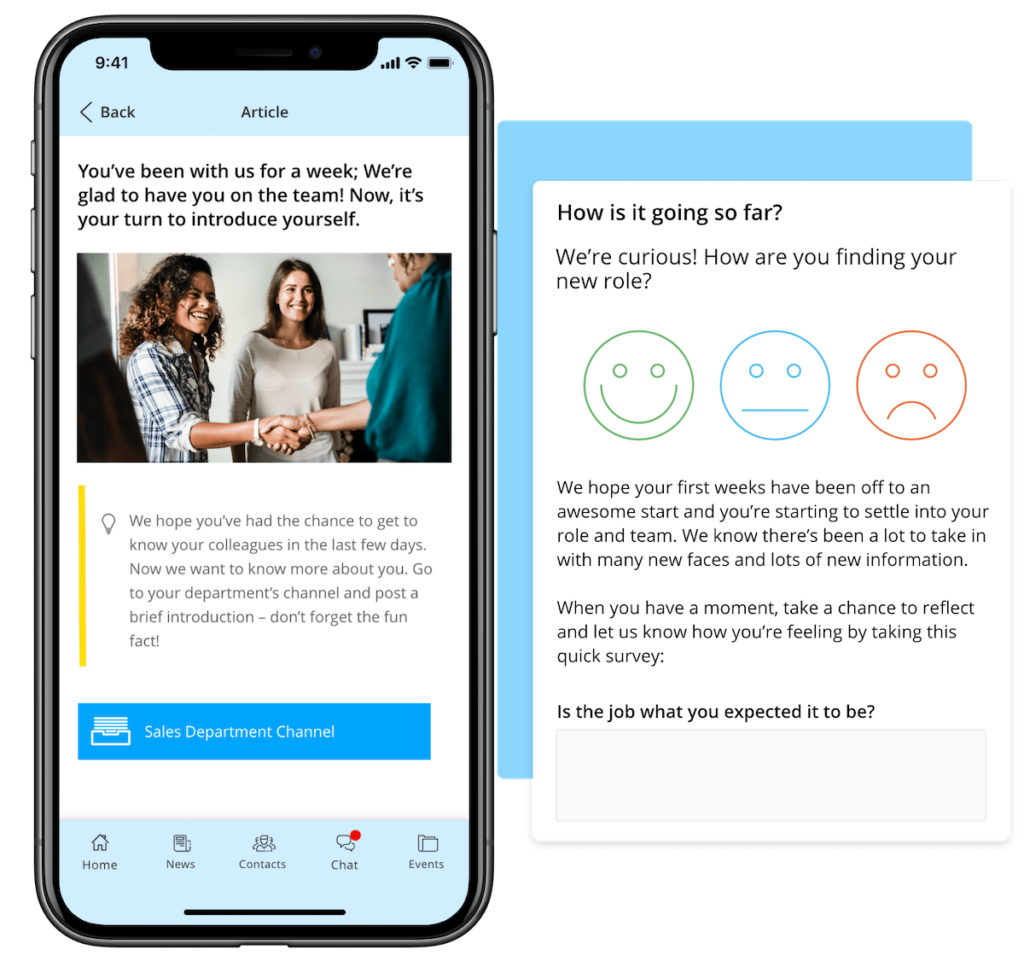4 Employee Onboarding Checklists: New Hires, Remote Workers, Managers, and HR
Onboarding checklists provide a consistent and comprehensive onboarding experience for every new hire. Here's how to create a checklist that's sure to engage your new hires from day one onwards.

What is Employee Onboarding?
Employee onboarding is a pivotal process for integrating new hires into an organization, starting with pre-boarding activities like sending welcome packages, preparing workstations, ensuring access to necessary systems — and also providing an onboarding checklist.
Orientation follows, featuring a welcome session to introduce the company’s culture, mission, values, and key policies, along with completing necessary paperwork and compliance tasks. Training tailored to the new hire’s role, mentorship programs, and meetings with team members help build relationships and ensure the new employee is ready to meet their responsibilities. Overall, providing a structured onboarding checklist throughout the process can help new employees feel immediately connected, supported, and aligned with company culture.
Why is that important? According to BambooHR, onboarding helps new hires feel 18 times more committed to their new employer compared to employees who felt their onboarding was less effective. Furthermore, 89 percent say that an effective onboarding experience made them feel “very engaged” at work and 30 times more likely to feel overall job satisfaction.

Why you need a checklist for successful new hire onboarding
A successful employee onboarding program is more than a checkbox exercise for Human Resources. Every employee follows their own distinct journey, and tools that facilitate individually tailored onboarding can be hugely beneficial to all concerned. Nevertheless, a good old-fashioned employee onboarding checklist is certain to be highly beneficial. It will ensure that all essential onboarding steps are covered, nothing is overlooked, and the overall process is smooth and organized.
As part of a package of onboarding documents, a checklist helps to standardize the onboarding process. Done effectively, it can provide new hires with a clear and structured path to becoming productive and engaged team members.
Employee onboarding examples on a timeline
A timeline-based onboarding checklist ensures that all essential steps are systematically covered, providing new hires with a clear and organized path to becoming productive and engaged team members.
The following checklist provides some basic onboarding examples. This timeline provides a structured approach to onboarding, helping new employees acclimate and become productive members of the organization.
Pre-boarding (1-2 Weeks Before Start Date): Day -14 to Day -7
Completed
Send a welcome email, including offer letter and payroll information.
☐
Set up workstation, including computer, phone, and any necessary software.
☐
Create access credentials (ID badge, building access).
☐
Schedule orientation and initial meetings.
☐
Send a welcome email with details regarding start date, including dress code, arrival time, and parking information.
☐
First Week: Day 1
Conduct a welcome session and provide an office tour.
☐
Introduce the new hire to team members and key stakeholders.
☐
Complete HR paperwork and compliance forms.
☐
Provide an overview of the company’s mission, values, and culture, often found in your organization’s employee handbook.
☐
Set up the new hire’s workstation and ensure all equipment is functioning.
☐
Review the first week’s schedule and expectations.
☐
First Week: Day 2–5
Conduct job-specific training sessions (e.g., software, tools, processes).
☐
Assign a mentor or culture buddy to guide the new hire.
☐
Schedule daily check-ins with the supervisor to address any questions.
☐
Introduce the new hire to ongoing projects and workflows.
☐
Provide access to resources and documentation.
☐
Encourage participation in team meetings and informal gatherings.
☐
First Month: Week 2
Continue job-specific training and development.
☐
Schedule regular check-ins and feedback sessions (weekly).
☐
Review the new hire’s progress and set short-term goals.
☐
Facilitate meetings with cross-functional teams.
☐
Encourage participation in company events and social activities.
☐
Address any questions or concerns.
☐
First Month: Week 3–4
Conduct additional training as needed.
☐
Begin assigning more complex tasks and responsibilities.
☐
Schedule a meeting to discuss initial impressions and gather feedback.
☐
Ensure the new hire feels supported and integrated within the team.
☐
Plan for continued mentorship and support.
☐
First 90 Days: Month 2
Continue regular check-ins and feedback sessions (bi-weekly).
☐
Provide opportunities for the new hire to take on larger projects.
☐
Schedule meetings with senior leadership for broader company insights.
☐
Discuss career development plans and opportunities for growth.
☐
Review progress towards initial goals and adjust as needed.
☐
First 90 Days: Month 3
Conduct a formal performance review to evaluate the new hire’s progress.
☐
Discuss long-term goals and set expectations for the next quarter.
☐
Solicit feedback on the onboarding process to identify areas for improvement.
☐
Ensure the new hire feels fully integrated into the team and company culture.
☐
Plan for continuous support, professional development, and ongoing mentorship.
☐
New employee onboarding checklist template
 Mobile employee communication tools can put your employee onboarding checklists right into the pockets of your people.
Mobile employee communication tools can put your employee onboarding checklists right into the pockets of your people.
Onboarding is particularly important for engaging remote employees as it sets the foundation for their integration and productivity. A structured onboarding process helps remote employees feel connected, supported, and aligned with company culture.
Here’s an onboarding checklist specific to remote employees. This checklist helps ensure that they are being effectively onboarded, supported, and integrated into the company, despite the physical distance. This checklist can be modified to the specific needs of your organization and personalized to your new hire.
Pre-boarding (Before Start Date)
Completed
Receive offer letter and welcome package.
☐
Prepare workstation and equipment (computer, phone, etc.).
☐
Set up email and necessary software accounts.
☐
Create access credentials (ID badge, building access, etc.).
☐
Schedule orientation and initial meetings.
☐
Send a welcome email with first-day details.
☐
First Day
Welcome session and office tour.
☐
Introduction to team members and key stakeholders.
☐
Complete HR paperwork and compliance forms.
☐
Provide an overview of the company’s mission, values, and culture.
☐
Set up workstation and ensure all new equipment works.
☐
Review the first week’s schedule and expectations.
☐
First Week
Job-specific training (software, tools, processes).
☐
Assign a mentor or culture buddy for guidance.
☐
Schedule daily check-ins with the supervisor.
☐
Introduction to ongoing projects and workflows.
☐
Provide access to resources and documentation.
☐
Encourage participation in team meetings and informal gatherings.
☐
First Month
Regular check-ins and feedback sessions (weekly).
☐
Review progress and set short-term goals.
☐
Provide additional training and development resources.
☐
Schedule meetings with cross-functional teams.
☐
Encourage participation in company events and social activities.
☐
Address any questions or concerns.
☐
First 90 Days
Conduct a formal performance review.
☐
Discuss career development plans and opportunities.
☐
Review long-term goals and expectations.
☐
Ensure the new hire feels integrated and supported within the team.
☐
Solicit feedback on the onboarding process.
☐
Plan for continuous support and development.
☐
Remote employee onboarding checklist template
 Mobile employee communication tools can put your employee onboarding checklists right into the pockets of your people.
Mobile employee communication tools can put your employee onboarding checklists right into the pockets of your people.
Onboarding is particularly important for engaging remote employees as it sets the foundation for their integration and productivity. A structured onboarding process helps remote employees feel connected, supported, and aligned with company culture.
Here’s an onboarding checklist specific to remote employees. This checklist helps ensure that they are being effectively onboarded, supported, and integrated into the company, despite the physical distance. This checklist can be modified to the specific needs of your organization and personalized to your new hire.
Pre-boarding (1-2 Weeks Before Start Date)
Completed
Send offer letter and welcome package.
☐
Ship necessary equipment (laptop, headset, etc.) and ensure it arrives before the start date.
☐
Set up email, VPN, and other necessary software accounts.
☐
Schedule virtual orientation and initial meetings.
☐
Send a welcome email with first-day details and access to online resources.
☐
Provide access to employee app, company intranet, collaboration tools (e.g., Slack, Teams), and HR systems.
☐
First Day
Conduct a virtual welcome session and provide an overview of the company.
☐
Virtual introduction to team members and key stakeholders.
☐
Complete HR paperwork and compliance forms electronically.
☐
Set up workstation and ensure all equipment is functioning.
☐
Review the first week’s schedule and expectations.
☐
Introduction to remote work best practices and communication tools.
☐
First Week
In-depth orientation on company policies and procedures via video conferencing.
☐
Job-specific training sessions (software, tools, processes) through virtual platforms.
☐
Assign a virtual mentor or buddy for guidance.
☐
Schedule daily check-ins with the supervisor to address any questions.
☐
Introduce ongoing projects and team workflows.
☐
Provide access to resources and documentation in the company’s digital repository.
☐
Encourage participation in virtual team meetings and informal online gatherings.
☐
First Month
☐
Regular check-ins and feedback sessions (weekly) via video call.
☐
Review progress and set short-term goals.
☐
Continue job-specific training and development through online courses.
☐
Facilitate virtual meetings with cross-functional teams.
☐
Encourage participation in virtual company events and social activities.
☐
Address any questions or concerns about remote work setup or processes.
☐
First 90 Days
Continue regular check-ins and feedback sessions (bi-weekly) through video conferencing.
☐
Conduct virtual team assessments to identify strengths and areas for improvement.
☐
Start developing strategies for remote work improvements and efficiencies.
☐
Schedule virtual meetings with senior leadership for broader company insights.
☐
Review long-term goals and align with company objectives.
☐
Plan for the implementation of any new remote work processes or tools.
☐
Solicit feedback on the remote onboarding process and support provided.
☐
Conduct a formal performance review and set long-term goals for self and team.
☐
Ensure the remote employee feels fully integrated into the team and company culture through regular virtual interactions.
☐
Employee onboarding checklist template for managers
 The following checklist provides a structured approach for helping managers systematically guide new hires through the onboarding process, ensuring consistency, efficiency, and thoroughness in employee integration.
The following checklist provides a structured approach for helping managers systematically guide new hires through the onboarding process, ensuring consistency, efficiency, and thoroughness in employee integration.
Here’s a sample onboarding checklist template for managers:
Pre-boarding (1-2 Weeks Before Start Date)
Completed
Send offer letter and welcome package.
☐
Prepare workstation, including computer, phone, and necessary software.
☐
Set up email, calendar access, and other necessary accounts.
☐
Schedule orientation and initial meetings with key stakeholders.
☐
Send a welcome email with first-day details and managerial resources.
☐
Provide organizational charts and team structures.
☐
First Day
Welcome session and office tour.
☐
Introduction to direct reports and key team members.
☐
Complete HR paperwork and compliance forms.
☐
Overview of company’s mission, values, and culture.
☐
Set up workstation and ensure all equipment is functioning.
☐
Review the first week’s schedule and expectations.
☐
Introduction to managerial tools and systems (e.g., performance management software).
☐
First Week
In-depth orientation on company policies and procedures.
☐
Job-specific training sessions (software, tools, processes).
☐
Assign a mentor or culture buddy from the leadership team.
☐
Schedule daily check-ins with a senior manager or executive.
☐
Begin understanding ongoing projects and team workflows.
☐
Review company’s strategic goals and departmental objectives.
☐
Introduction to key stakeholders and cross-functional teams.
☐
First Month
Schedule regular check-ins and feedback sessions (weekly).
☐
Review progress and set short-term goals for the team and self.
☐
Begin leading team meetings and one-on-one sessions with direct reports.
☐
Conduct a thorough review of team roles, responsibilities, and performance metrics.
☐
Familiarize with the company’s performance review process.
☐
Encourage participation in company events and social activities.
☐
Address any questions or concerns regarding team dynamics or projects.
☐
First 90 Days
Continue regular check-ins and feedback sessions (bi-weekly).
☐
Conduct team assessments to identify strengths and areas for improvement.
☐
Start developing strategies for team development and performance improvement.
☐
Facilitate meetings with senior leadership for broader company insights.
☐
Review long-term departmental goals and align with company objectives.
☐
Plan for the implementation of any new processes or improvements.
☐
Solicit feedback on the onboarding process and managerial support.
☐
Conduct a formal performance review and set long-term goals for self and team.
☐
Ensure full integration into the company culture and leadership team.
☐
HR Onboarding Checklist Template
The following HR onboarding checklist ensures that new hires feel welcomed, supported, and integrated into the company, laying a strong foundation for their success and long-term retention.
Here’s a comprehensive employee onboarding checklist with a timeline, focusing on tasks from a Human Resources perspective:
Pre-Arrival (Before Day 1)
Completed
1. Offer and Acceptance
Send official job offer letter and employment contract.
☐
Receive signed documents from the new hire.
☐
2. Preparation
Send a welcome email with the start date, time, location, and dress code.
☐
Set up workspace with necessary equipment (computer, phone, etc.).
☐
Arrange for building access (key cards, parking permits).
☐
Prepare new hire paperwork (tax forms, direct deposit forms, etc.).
☐
3. Company Introduction
Send an introduction email with company information, organizational chart, and employee handbook.
☐
Schedule initial meetings with key team members and stakeholders.
☐
Day 1
1. Welcome and Orientation
Greet the new hire and provide a tour of the facility.
☐
Conduct a brief orientation session covering company history, mission, vision, and values.
☐
2. Administrative Tasks
Complete necessary paperwork (tax forms, direct deposit, emergency contact information).
☐
Issue equipment and access credentials.
☐
Explain benefits and compensation package.
3. Meet the Team
Introduce the new hire to their team and key contacts.
☐
Arrange a team lunch or coffee break for informal introductions.
☐
Week 1
1. Training and Development
Provide an overview of the training schedule.
☐
Start with basic training sessions (e.g., HR policies, IT systems).
☐
2. Role Specific Training
Begin specific training related to their role.
☐
Assign a mentor or culture buddy for additional support.
☐
3. Check-in Meetings
Schedule a meeting with HR to address any questions or concerns.
☐
Arrange for regular check-ins with the direct supervisor.
☐
First Month
1. Ongoing Training
Continue role-specific training and development sessions.
☐
Introduce the new hire to ongoing projects and their responsibilities.
☐
2. Performance Goals
Set initial performance goals and objectives.
☐
Explain the performance review process and expectations.
☐
3. Feedback and Adjustment
Conduct a formal check-in meeting with HR to gather feedback.
☐
Adjust onboarding processes based on the new hire’s feedback.
☐
First 3 Months
1. Integration and Engagement
Encourage participation in team meetings and company events.
☐
Ensure the new hire is gradually taking on more responsibilities.
☐
2. Regular Check-ins
Maintain regular check-ins with HR and the direct supervisor.
☐
Address any challenges or additional support needed.
☐
3. Performance Review
Conduct a 90-day performance review.
☐
Provide constructive feedback and discuss long-term goals.
☐
First 6 Months
1. Continuous Development
Offer opportunities for further training and professional development.
☐
Encourage the new hire to seek out learning opportunities within the company.
☐
2. Social Integration
Foster relationships within the team and across departments.
☐
Encourage involvement in company culture and activities.
☐
3. Long-term Planning
Review progress towards initial goals.
☐
Set new objectives and career development plans.
☐
End of First Year
1. Annual Review
Conduct a comprehensive performance review.
☐
Discuss achievements, areas for improvement, and career aspirations.
☐
2. Recognition and Feedback
Recognize and celebrate the new hire’s contributions.
☐
Gather feedback on the onboarding process for continuous improvement.
☐
3. Future Planning
Plan for the new hire’s future with the company, including potential promotions or new roles.
☐
Update professional development plans accordingly.
☐









